THOSE PRECIOUS MOMENTS
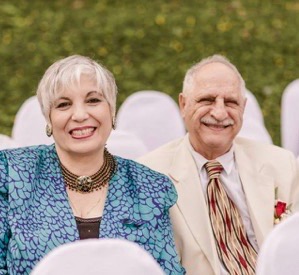
Dr. Firaydun and wife Giti
“The obligations of the Hands of the Cause of God, are to diffuse the Divine Fragrances, to edify the souls of men, to promote learning, to improve the character of all men and to be, at all times and under all conditions, sanctified and detached from earthly things. They must manifest the fear of God by their conduct, their manners, their deeds and their words.” – Abdu’l-Bahá
With the passing of the beloved Guardian in November 1957, appointments of further Hands of the Cause whom he called “Chief Stewards of Bahá’u’lláh’s Embryonic World Commonwealth”, ceased. The last living Hand of the Cause, Dr. Muhammad Varqa, passed away in Haifa on 22 September, 2007.
While some in our generation lived during the days of the Hands of the Cause, not all were privileged to meet them in person. I am truly blessed, having met fourteen Hands of the Cause of God. This story is a recollection of some of my memories based on personal experiences with four Hands of the Cause of God- Mr. Ali Akbar Furutan, Mr. Tarazu’llah Samandari, Mr. Abul Qasim Faizi and Mr. Collis Featherstone. They, including Hand of the Cause Dr. Muhajir, have deeply influenced my way of thinking and of serving the Cause of God.
They helped me to realize it is better to place myself in God’s hands and let the Will of God lead me in my acts of service and living a Bahá’í life. This mindset has given me the courage to pursue achieving tasks that once seemed impossible and beyond my capacity, and doors did miraculously open with the invisible Hands of God guiding my humble services.
Hand of the Cause of God Mr. Ali Akbar Furutan
Mr. Ali Akbar Furutan was the first Hand of the Cause of God that I met in 1957 in Tehran when I was sixteen years old. I had just moved from the Kurdish town of Qasr-i-Shirin to Tehran for my high-school education. The excitement of just meeting Mr. Furutan who had just come from Holy Land was beyond description. He talked about victories of the Ten Years Crusade-International Teaching Plan. At the end, many friends circled around him to get further enlightenment. I was the youngest one that stayed in the back and listened. I knew that I had no chance to get closer to him to tell him what was palpitating my heart. I wanted to tell him that I wanted to go pioneering to a goal country, and ask for a special prayer to fulfill this wish. Soon Mr. Furutan began to leave. I could not talk to him but I thought he must have heard what was in my heart. This wish was fulfilled years later after I had pioneered to Laos in 1962.
Mr. Furutan was a very humorous person. I remember that once in 1969 when Giti (my wife) and I were on our first pilgrimage in Haifa someone in our pilgrim group asked him a question related to Bahá’í view on child education. He wanted Mr. Furutan to explain a complex point written in one of his books. Mr. Furutan’s response was spontaneous, as he humorously said, “You must become a child to understand the kind of world that children roam in and see things from their own perspective”.
I met him again at the Hong Kong International Conference in November 1976 when he represented the Universal House of Justice. He and his wife Attaiyyih Khanum arrived in Hong Kong a few days prior to the Conference. Since I was the only member of the Continental Board of Counsellors living in Hong Kong, Giti and I were assigned to be with Mr. Furutan and his wife every day from the date of their arrival to his departure from Hong Kong. Hands of the Cause Dr. Muhajir and Mr. Featherstone were also present at this Conference.
The night before the Hong Kong International Conference Mr. Furutan asked me if the message of the House of Justice, addressed to the friends in the Conference, was translated from English into to Farsi since many Persian believers had come to attend the Conference. I replied that the National Spiritual Assembly had not considered doing that. He immediately asked me that even an unofficial translation of the Message would suffice to be read at the Conference. He asked me to make sure the translation of the Message into Farsi was done overnight and be made available in time for conference the following morning, and advised that the translation should not be distributed until it was approved by the National Assembly. However, my competence in the Farsi language had deteriorated slightly since I left Iran in 1962. But with some prayers and the help of a dictionary I managed to get the translation done. I had it checked out by a Persian believer. The National Assembly approved it and the translation was read following the reading of the English version. This incident taught me the importance of the messages of the Supreme Body reaching everyone each time it is released. And I also learnt the importance of getting the approval of the institutions for translations of important documents.
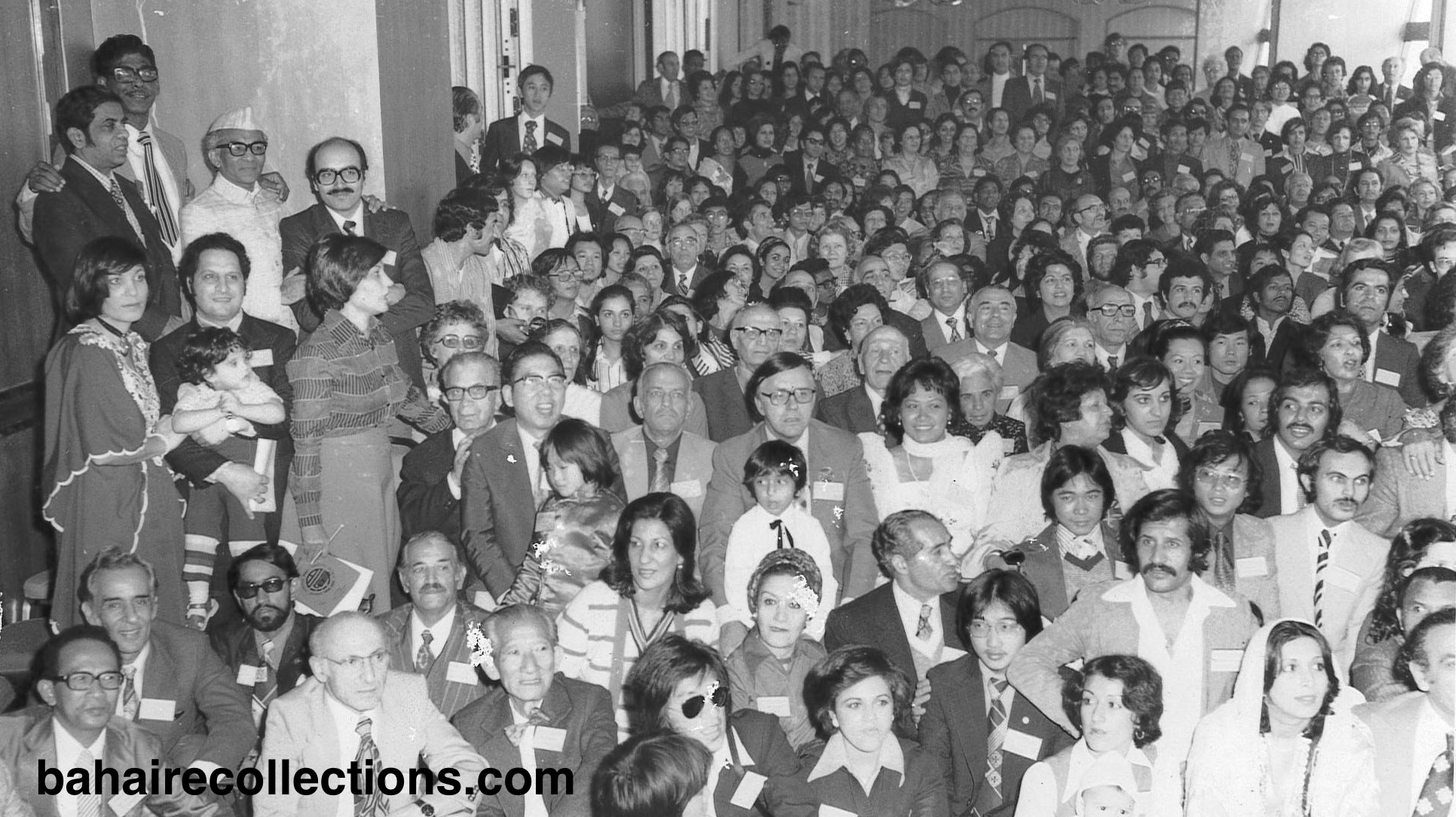
At the International Conference in Hong Kong, 1976. Firaydun is seen standing at left with his daughter Samoa in his hands. Standing at extreme left is Counselor Dr. C. J. Sundram. Seated in front row L-R are Counselors Vic. Samniego,K.H. Payman, Mumtazi and Yankee Leong
One night Mr. Furutan and his wife honored us by coming to our apartment for dinner. Hands of the Cause Dr. Muhajir and Mr. Collis Featherstone and some Counselors were also present at that dinner. We had prepared Chinese and Persian dishes and dined together with much joy and laughter. That day I accompanied Mr. and Mrs. Furutan to our apartment about an hour earlier so that they could spend some time alone and rest. He would allow our daughter Sahba, then five years old, to be seated on his lap and recite prayers and sing Bahá’í songs. We tried to stop Sahba from bothering Mr. Furutan, but Mr. Furutan invited Sahba to sit on his lap and continue the Bahai prayers and songs. After dinner Mr. Furutan remarked that one of the great joys of the beloved Guardian was remembering the pioneers who had established themselves in faraway lands to spread the teachings of Baha’u’llah. Mr. Furutan also said that with the settlement of pioneers came blessings, progress, development and the favors of God to those lands.
At a later meeting in Haifa, he spoke about the importance of obedience and respect for the institutions of the Faith. He looked at me and asked, “You live in Laos and you know how people in South-East Asia are easy-going and informal.” I just nodded. Then he told us this story. He was representing the beloved Guardian at the first Convention for the election and establishment of the first Regional Spiritual Assembly of the Bahá’ís of South-East Asia in Jakarta, Indonesia during Ridvan 1957. Several Indonesian tribal believers attended this convention. A day before the Convention the organizers accompanied Mr. Furutan to see the tribal believers where they were accommodated. The Indonesian believers knew the Hand of the Cause Dr. Muhajir well, but never knew that Mr. Furutan was also a Hand of the Cause. So, they simply introduced Mr. Furutan as Dr. Muhajir’s father-in-law. As Mr. Furutan was introduced to them they were still lying down and relaxing. All they said was “Hi” and continued relaxing on the floor. Mr. Furutan had to walk carefully in between the stretched legs of the tribal believers to the spot where he was directed to be seated. Then one of the accompanying persons began introducing Mr. Furutan as a Hand of the Cause of God, who was representing the beloved Guardian at the Convention. As soon as this was said, the atmosphere of the room changed at once. Everyone rose and sat upright, full of reverence and yet visibly shaken, as they had a great respect for the Guardian. Mr. Furutan said that they were right in not respecting him as an individual, and what they respected was the institution of the Guardian and the Hand of the Cause of God. He said the institutions divinely ordained by Bahá’u’lláh must be respected at any cost.
Since the time of knowing Mr. Furutan, I was continuously communicating with him. He wrote several letters to me. He wrote me a letter dated 17 May, 1979 in Persian literary style.
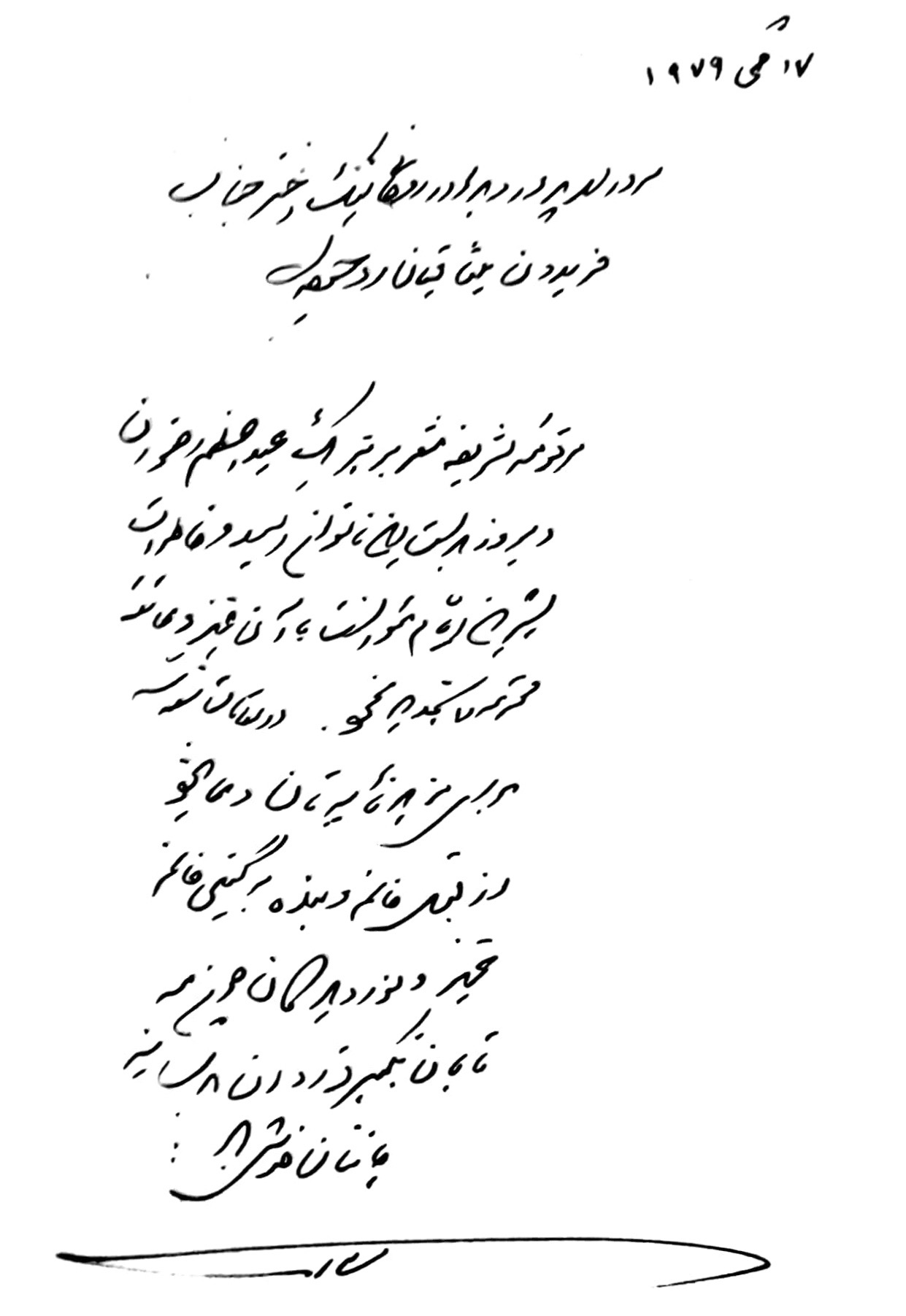
Letter from Mr. Furutan to me
The translation of the above letter is as below:
“Dearly loved friend and spiritual brother Nik Akhtar (adorable star), Firaydun Mithaqiyan (Mithaq) for whom my soul be a sacrifice. Your honorable letter of the Great Ridvan Greetings reached yesterday to this feeble servant and refreshed the sweet memories of the days of our familiarity with you and your dear family. In the Holy Shrines, you will be remembered with ardent prayers for additional divine confirmation. Please convey my wife’s and my own loving greetings to Giti Khanum and your lovely children that are noor didegan (lights of the eyes and Mahe Taban (the shiny moon). Be Happy.”
Mr. Furutan passed away at the age of 98, on the Day of the Covenant in 2003.
Hand of the Cause of God Mr. Tarázulláh Samandari
The next Hand of the Cause of God that I met was Mr. Tarázulláh Samandari. I met him for the first time in 1958 in Tehran. I was seventeen. Mr. Samandari attained the presence of Bahá’u’lláh at the age of sixteen when he met Baha’u’llah many times during his seven months of pilgrimage. He had met Abdu’l Baha and Shoghi Effendi many times. He had also been alone with Bahá’u’lláh in the room when Bahá’u’lláh was revealing a Tablet. Later the Supreme Body had sought his assistance in identifying the writings of Baha’u’llah as he was familiar with them
The meeting in 1958 was a small gathering of about sixty believers. I was sitting in the front row facing him clearly. He had a cold and was wearing a heavy, black overcoat and had a handkerchief in his hand. He said, “I have a cold and am not feeling well. My family wanted me to cancel my coming here and rest. But the love I have for you did not allow me to do that. Therefore, I am happy that I am here today with you.” I remember he talked about the work of the Hands of the Cause of God in the Holy Land after the sudden passing of the beloved Guardian. My eyes and ears were captivated by his shinny eyes, sweet smile and vibrant face. In that first meeting, I had no chance of meeting him individually as he had a tight schedule visiting the Bahá’í communities in Iran. Only I hoped on finding the opportunity of meeting him again in future. Suffice it to say, I was very privileged to have seen the very eyes that had fallen upon the countenance of the Blessed Beauty.
Seven years later when he visited Laos in 1966 I had the honor of being his interpreter on various occasions and gatherings. Samandari came with his son, Dr. Mehdi Samandari, after touring Malaysia, Thailand, Laos, Taiwan, Philippines, Korea, and Japan. At that time Bijan Bayzayee and I were away in the mass-teaching area of Thakhek and had no knowledge of the Hand’s arrival in Laos. A telegram was sent to us in Thakhek to inform us that Mr. Samandari had arrived in Vientiane and that we were to go to meet him at once. But it was only on the third day of Mr. Samandari’s arrival that we got the telegram, and we immediately proceed to Vientiane by bus. In Vientiane, when we meet the Hand of the Cause of God Mr. Samandari, we felt as though we were in heaven. It was such a bounty to be in his presence and to hear wonderful stories that he shared with friends in Vientiane and Luang Prabang. The National Teaching Committee of Laos, that was just a few months old, held a meeting to consult on a plan for the visiting Hand. The time was short and had to be utilized most efficiently.

Vientianne Airport, Laos, October 1966. L-R:Bijan Bayzayee, Manijeh Javid Bayzayee, Mr. Samandari, Yankee Leong, Dr. Mehdi Samandari and Firaydun
Initially, the National Teaching Committee thought of organizing the Hand’s visit to Takhek and Sayaboury, but due to lack of proper transportation, it was decided to consider a different plan and arranged for him to visit the believers in Luang Prabang, the royal capital of Laos. this was the only city that had a suitable hotel with basic facilities and a tribal Baha’i village called Nogh-Viang, in its neighborhood. The village that housed many believers representing various tribal Bahá’í communities appeared to be the best choice for the Hand to spend three nights and days meeting the friends. The National Teaching Committee decided that I should accompany the Hand of the Cause and his son Dr. Mehdi to Luang Prabang on the first available flight. Fortunately, everything worked well, and on the following day the Hand of the Cause Mr. Samandari, Dr. Mehdi and I flew to Luang Prabang.
Upon arrival, Mr. Samandari was taken to his hotel for lunch and a short rest. Meanwhile I went to the friends to arrange the meetings. Mr. Samandari’s schedule allowed two nights of stay. The Local Spiritual Assembly decided to hold one large meeting on the first night, and smaller group meetings on the second day and night. The large meeting was decided to be held at the village of Nogh-Viang, located at the edge of Luang Prabang city with a population of a few hundred people. Most the Nogh-Viang population had embraced the Faith and had built their own Bahá’í Center on a small piece of land donated by a tribal believer. The question was how to take the Hand of the Cause two kilometers away from his hotel to Nogh-Viang at night. The common means of travel was walking on foot, bicycles, motorcycles, and rickshaws. We didn’t know what to do. Fortunately, a local Bahá’í friend solved the problem by contacting the driver of the royal limousine that was usually used to transport international guests and high government officials. Arrangements were made to take Mr. Samandari and his companions to the meeting in Nogh-Viang and back to his hotel with the dignity.
The gathering at Nogh-Viang was held on the first evening where nearly one hundred people attended. Since the room was small, only about thirty-six believers could sit in the room, while the rest of people tried to hear Mr. Samandari’s talk from outside. Mr. Samandari had to stand at the doorway so that all could hear him while he delivered a majestic talk on the station of Baha’u’llah. He spoke in Persian. I stood one step behind him and translated his talk to Laotian.
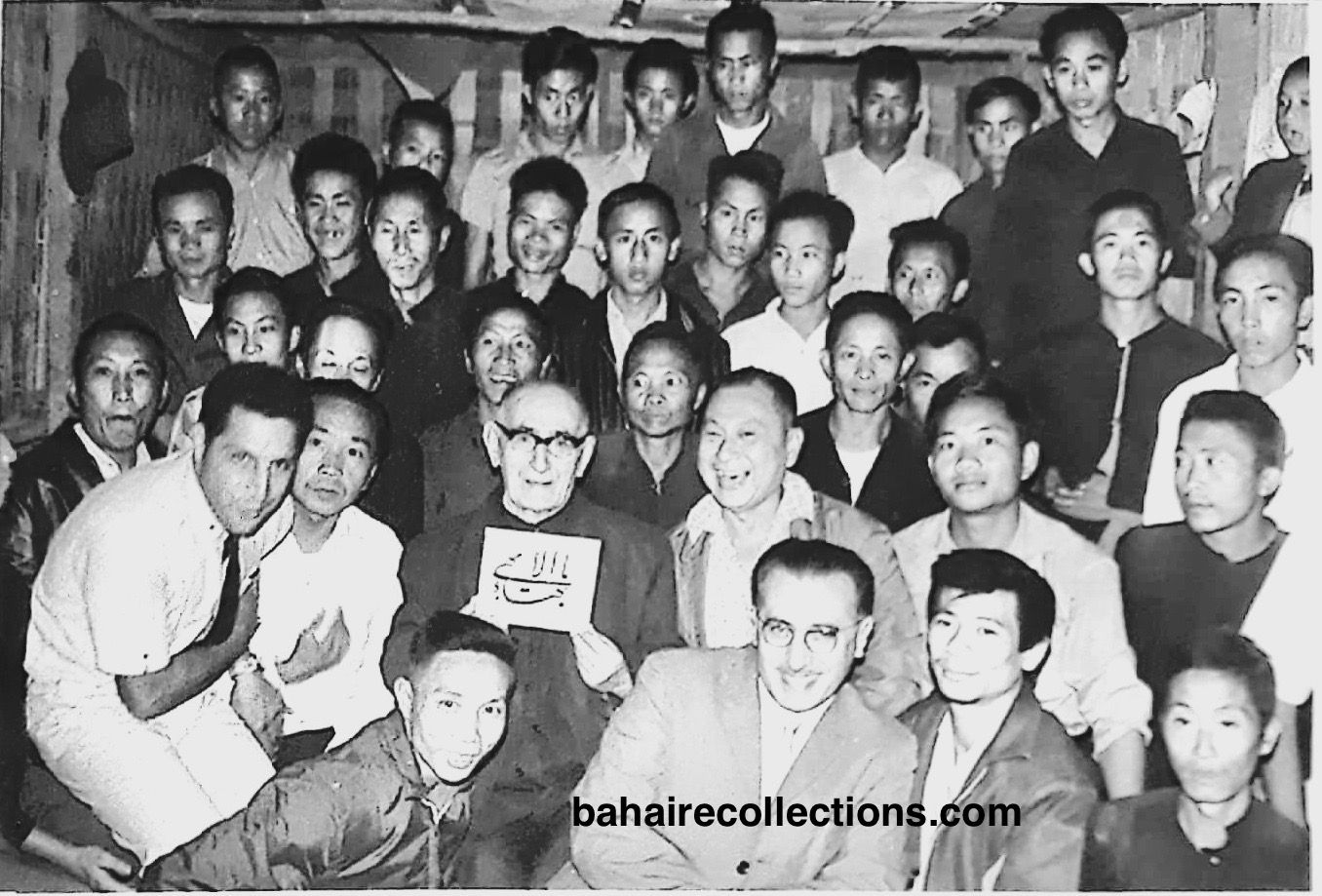
Mr. Samandari with tribal friends in Nogh Viang village. Firaydun is seated extreme left and Dr. Mehdi in front, centre
On the second day, over a hundred-people gathered to hear him speak in the hotel. They included Bahá’ís, Christians, Buddhists and the atheists. They all had great impressions on Mr. Samandari. One Christian said he was like an apostle of Christ, some Buddhists thought Mr. Samandari was a Holy Monk. The friends who heard him were so inspired that they rose to commit themselves to further teaching and expansion of the Cause in their tribal communities. The visit of the Hand was successful in making an imperishable spiritual influence on every soul that met him.
I also had the bounty of traveling with him to Luang Prabang city- the royal capital of Laos. Every minute and every moment of being in his presence brought me precious lessons that was engraved within me for the rest of my life. When I was alone in his presence, he would tell me stories of his travels and services to the Cause of God. Being alone with Mr. Samandari for two days in the hotel room he graciously enlightened me with invaluable explanations on several aspects of the teachings. I also asked him about his meetings with Baha’u’llah.
The following story he graciously related to me in the presence of his son in the hotel in Luang Prabang was something that had not been published anywhere. He said, “On the ninth day of Ridvan a tent was pitched under the shade of trees in Bahji. Many believers had gathered to celebrate the occasion in the presence of Baha’u’llah who sat in the tent and was facing the believers. Since the tent was full I, a boy of sixteen, knew I had no chance of getting close to Baha’u’llah. Therefore, I decided to sit outside the tent, but close enough to Baha’u’llah where I could still see Him and hear His words loud and clear. At the end of the celebration, trays of fresh oranges were served, but were not sufficient for all. Therefore, some children, myself included, sitting outside the tent could not get our share. When Baha’u’llah blessed each one with a gift of an orange and left the tent I followed Him. Baha’u’llah was fully aware that I was sitting outside the tent and listening to Him. Suddenly Bahá’u’lláh turned back, looked at me and gave me His own orange, and left. When the other boys witnessed this special gift from Bahá’u’lláh, they rushed toward me to snatch the orange from me. Seeing the situation too critical, I began to run fast, and as I ran I ate the precious orange along with the peel. To me it was so precious that I did not want to share it with others.”
After completing Mr. Samandari’s program in Luang Prabang city, we came back to the hotel. He asked his son Dr. Mehdi, to write a calligraphy for me on his behalf, since his hand was less steady at his advanced age. He signed his name on the Calligraphy of “The Greatest Name” and presented it to me. This was the most precious gift that I ever received!
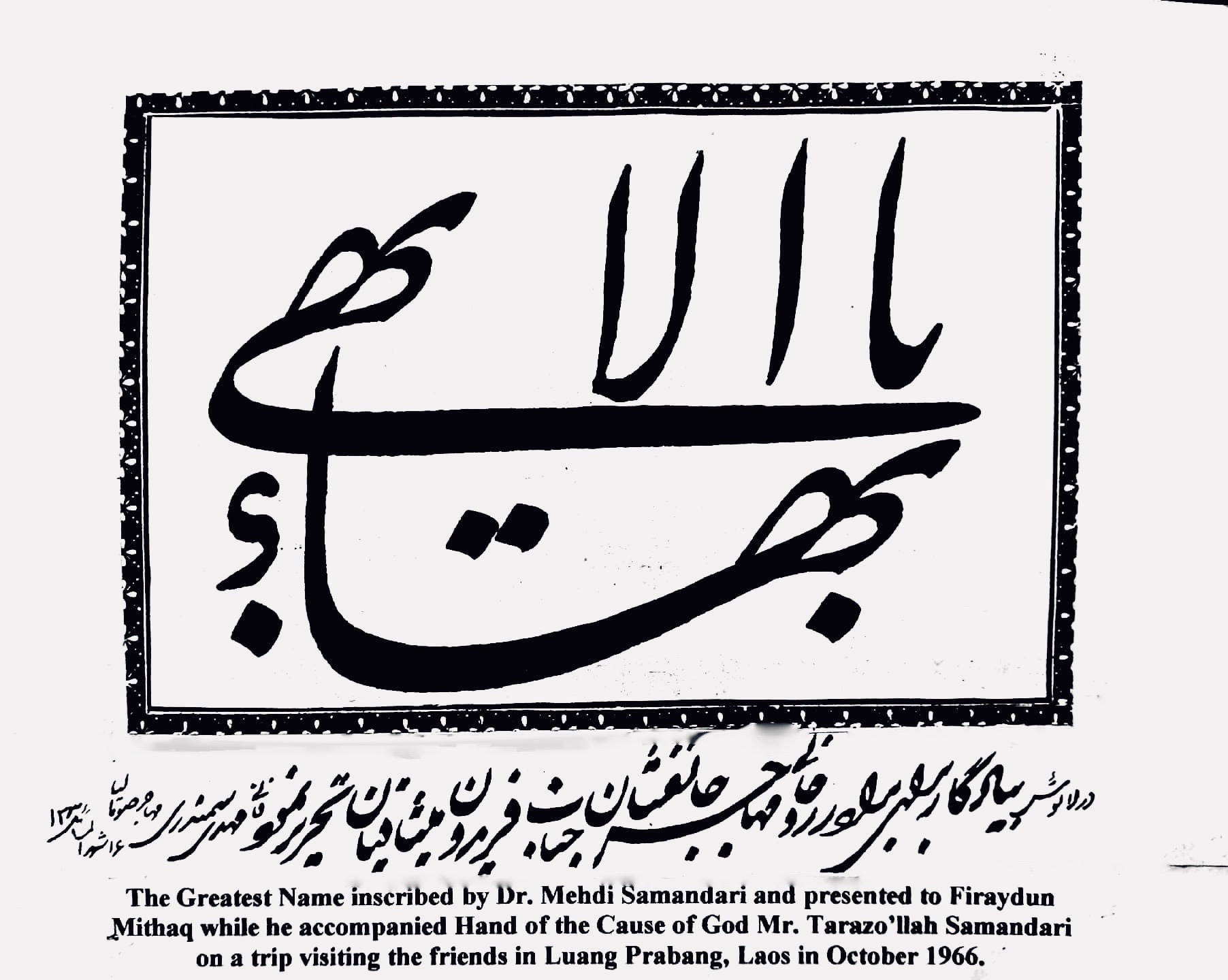
He passed away on September 2, 1968, at the age of 93. Having attained his expressed wish to die near the two Holy Shrines, he was buried at the foot of Mt. Carmel.
Hand of the Cause of God Mr. Abul Qasim Faizi
Mr. Faizi was an extremely adorable person that his love penetrated deeply in the hearts of all those that knew him. He wrote thousands of letters to the pioneers, teachers and servants of Baha’u’llah all around the world and kept nourishing and encouraging them. He often decorated those letters with colorful and artistic drawing and Bahá’í quotations. My family and I had the bounty to be the recipient of over a hundred letters that he sent us during our 29 years of association with him till he passed away to Abha Kingdom.
It was here at the Intercontinental conference in India in October 1967 that I met Mr. Faizi for the first time. Mr. Faizi had arrived in New Delhi a few days prior to the opening of the Conference. I desired to meet Mr. Faizi closely in a gathering of over 2000 believers participating in the Conference, that seemed impossible. In the morning of the second day of the Conference Mr. R. N. Shah, Secretary of the National Spiritual Assembly of India sent a messenger with a message that Mr. Faizi wanted to see me and the four new Tibetan believers at 2 in the afternoon at the Secretary’s office. It is to be noted that entering of Tibetans under the banner of Baha’u’llah had been for some years the goal of the National Community of India that had remained unachieved till eighteen days before the opening of the Conference when fifty-three Tibetans in the Himalayas region declared. Four of them came for the Conference. I undertook one month of teaching trip to the north of India prior to the Conference as per the advice of Hand of the Cause Dr. Muhajir. I was with the Tibetans in Himalayas for five days and shared the Message of Baha’u’llah. It was only at the New Delhi Conference that I learned they were the very first Tibetans ever that have embraced the Faith.

Mr. Faizi with the Tibetan believers at the New Delhi Conference in October 1967. Firaydun is at extreme left
The four Tibetan believers and I had the honor of having an unforgettable meeting with Mr. Faizi. In this rare and exceptional meeting, the four Tibetan friends interacted with Mr. Faizi and received much love from him. Each of the four Tibetan friends took turns to place a white cotton scarf on the shoulders of Mr. Faizi that was their custom of showing love and respect to elders. They chanted the well-known prayer of Allah-u-Abha and a unity song in Tibetan. Mr. Faizi hugged each of them with tender love and wished them well. I too was blessed to get the share of his first ever warm embracing hug. Then he asked me about the friends in Laos, and told me to convey his love to them. Then he said he will come to Laos to meet them.
Mr. Faizi visits Laos
The six days visit of Mr. Faizi to Laos in December 1968 was an added bounty for Laos. From the moment, he stepped into Vientiane airport till the day he left, I walked in his shadow as a translator and officer in attendance. In this visit he met with the National Spiritual Assembly and the believers at large, and gave a public talk about Baha’u’llah at the prestigious Lan-Xang hotel. On the next day, he said he wished to purchase a copy of the Lao traditional music and songs to be taken to the Bahá’í Archive in Haifa. We searched the shops but none was available. That afternoon I went to the Radio station and asked for a copy of Lao traditional music. But they too did not have one that could be given, because their music was recorded on large reels for the station’s uses. But when they knew what it was for a prestigious visitor, they offered to record a copy for us if we could give them a blank cassette tape. We did that and the tape was ready the next day. During his stay in the hotel, he met groups of friends at the hotel’s lobby coffee shop.
I remember one evening when Mr. Faizi saw the impoverished state of the capital city of Vientiane and its poor infrastructure, he told us how impoverished Bahrain was in the forties when the city was without electricity, running water, proper sanitation and decent means of living. He had to walk nearly a kilometer to the community well to take a bucket of water and carry it home. He continued saying that when the pioneers come to a country that is ruinous and poor, God’s blessings come with them, and developments follow. He then made a remark, “Look at the condition of Bahrain twenty years later. The development is incredible. Therefore, in time to come the same development will happen in Laos, since Laos has Bahá’í pioneers.”
When my wife Giti and I were in the Holy Land on pilgrimage, Mr. Faizi graciously invited us for lunch to his apartment. We had a joyful conversation as he told us stories about the greatness of the Cause and the works of the Guardian. I saw his desk was full of papers and correspondence materials. The walls and the furniture in his room were decorated beautifully with calligraphic works and artistic drawings. He asked me if I was writing a diary of my Bahá’í activities. I replied no since my English was poor and my writing ability was zero. Mr. Faizi advised me, “Start writing from today you will see that ideas and words gushing out and streaming from your pen.” I have tried to follow his advice and to some extent I am able to write. Every moment with Mr. Faizi brought so much inspiration. To all the questions I raised, he gave not only in-depth answers, but most of the answers were given in a totally different angle, which only provoked my thoughts and tempted me to meditate further. He was indeed a well-read Hand of the Cause.
Once Mr. Faizi sent me two sets of calligraphic works, dated 24 May 1971, artistically written in green and decorated with two quotations.

Two sets of calligraphy that Mr. Faizi gifted me
A rough translation of the above says:
“The content of the letter in brief contains words of encouragement and gratitude while turning our attention to the divine assistance and promising that our services will bear fruits in time. Doors will open and the hardships will turn to blessing and joy. He mentions that he has enclosed a few quotations from the Writings for our fellow pioneers in Laos. Referring to the Writings he exalts the services of pioneers and teachers of the Faith. Saying that next week he is going to Iran for two and half months to meet the believers particularly the youth and children that have a great potential for service. He hopes that he will be able to render a humble service to the friends in Iran. He encourages us to write the happy news of the progress of youth and children in Laos. He finally conveys his hugs and kisses to our children and assures us of his ardent prayers in the Holy Shrines. In his other short letter written in black ink he conveys his love and appreciations and apologizes for delay in replying due to sickness but with the grace of God he is recovering and getting back to his normal activities. Finally, he prays for us and beseeches divine confirmations.”
Hand of the Cause of God Mr. Collis Featherstone
I had the bounty of meeting the Hand of the Cause of God Mr. Featherstone many times in Thailand, Laos, Malaysia, Singapore, India, the Holy Land, Hong Kong, Australia and South Korea. Several times I had the honor of traveling with him when visiting Bahá’í communities in other cities, towns and villages in Laos, South Korea and Australia. I was blessed to spent many hours with him and partake of his knowledge, his especial way of interaction with people others, his teaching methods and keen interest in delving into the Writings. In him I saw qualities of kindness, love and devotion to service. He was very orderly, precise and straightforward. His favorite talk was on the Covenant, and obedience to institutions. Whenever he answered questions related to covenant his face beamed with radiance, his voice roared like a lion.
The first time I met him was in 1965 in Bangkok during the second National Convention. From that first encountering, I knew I could learn a lot from him. Therefore, during the convention breaks, I sat either close to him or on the other side of table to see his face, to listen to what he said. I would occasionally ask questions. Most of our discussions that usually took place during lunch and supper circled around teaching and consolidation work. He gave us valuable tips and guidance from the beloved Guardian and the Universal House of Justice. I asked if he was coming to visit Laos. His reply was positive but he wasn’t sure of the date of his visit.
Mr. Featherstone visits Laos
Mr. Featherstone made his first visit to Laos in October 1970, and his second visit in September 1974. I had the bounty to be his translator and traveled with him. He met with both the National Spiritual Assembly and the Local Spiritual Assembly in Vientiane and consulted about the consolidation of the new believers that had declared in the recent years. He emphasized on starting children classes in the villages wherever the Bahá’ís resided. He personally told me about the vitality of children classes in strengthening the future foundation of the Faith in Laos. He urged me to consult with the institutions and follow up with this matter. He met the believers formally and informally at his hotel lobby and sometimes in our residence. In all these meetings, he talked about the importance of children classes. His hotel was close to our house and so he would come for a cup of tea and discussions. We gave a dinner in his honor at our house and invited the believers in Vientiane to come and dine with him. Nearly forty friends gathered and we had a great and uplifting time in his presence. That evening Mr. Featherstone spoke about the life of the beloved Guardian, on the request of the friends.
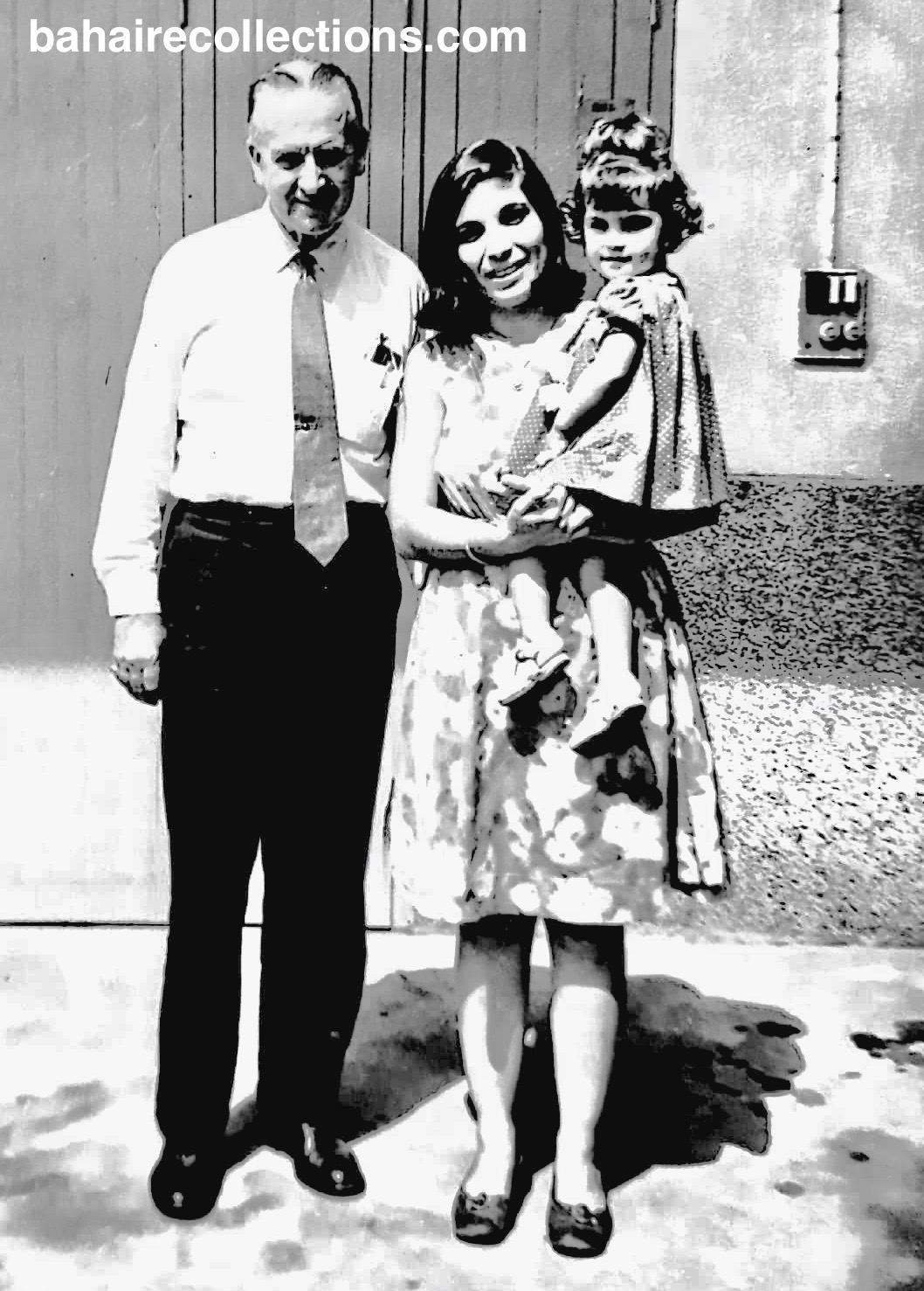
Giti holding daughter Sahba aged 2, with Mr. Featherstone in Vientiane, 1970
His sense of humor and adaptability to various cultures was something I loved in him. In a gathering of local friends, he asked how they would greet one-another when they met. After everyone had given his piece, he told us that of greeting in an aboriginal island in the pacific that was quite different. To demonstrate this custom of greeting a visitor, he asked a youth to come and stand in the middle of the room. Mr. Featherstone stood a few meters away facing the youth. Screaming with joy Mr. Featherstone ran towards him, hugged his legs, lifted him up, turned and twisted him around while he was still screaming with joy. This demonstration shook the entire gathering with loud laughter. He carried himself well representing the institution of the Hands, and yet was down to earth.
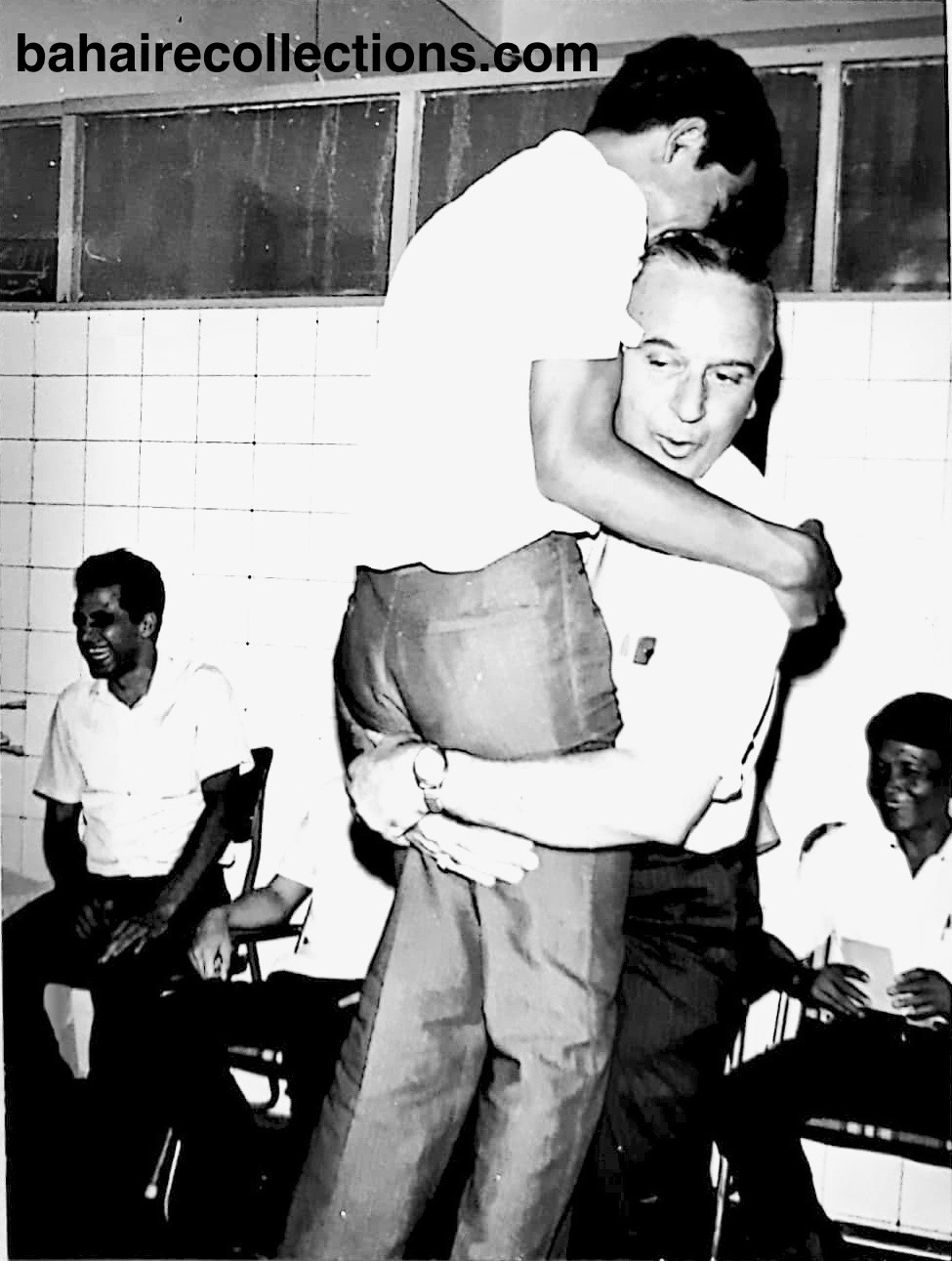
Mr. Featherstone demonstrating the greeting custom of the Pacific islanders
I had bounty of traveling with him by air to Savannakhet where he met thirty friends, mostly youth and encouraged them to share the message of Baha’u’llah with their parents and families. There he inspected a plot of land in the center of the city that had been recently purchased for building the National Teaching Institute of Laos. During this trip, I took the opportunity of getting his advice on the draft of the booklet I had researched and written about the Buddhist prophesies titled “Baha’u’llah and Fulfillment of Buddhist Prophesies”. He kindly and attentively went through it and made a few comments that I took it to heart and used it. The National Spiritual Assembly published it three times. It was also published in the United States for circulation among the Lao refugees that were investigating the Faith.

Firaydun and Mr. Featherstone visiting the plot of land in Savannakhet, 1970
On his second visit in September 1974, Mr. Featherstone paid a visit to two mass-teaching villages in Viang Kham area. In the first gathering that the Hand of the Cause addressed were small groups of believers and some people of interest that wanted to meet him and hear about Baha’u’llah. He made a deep impression about the validity of the Faith in the predominantly Buddhist community.
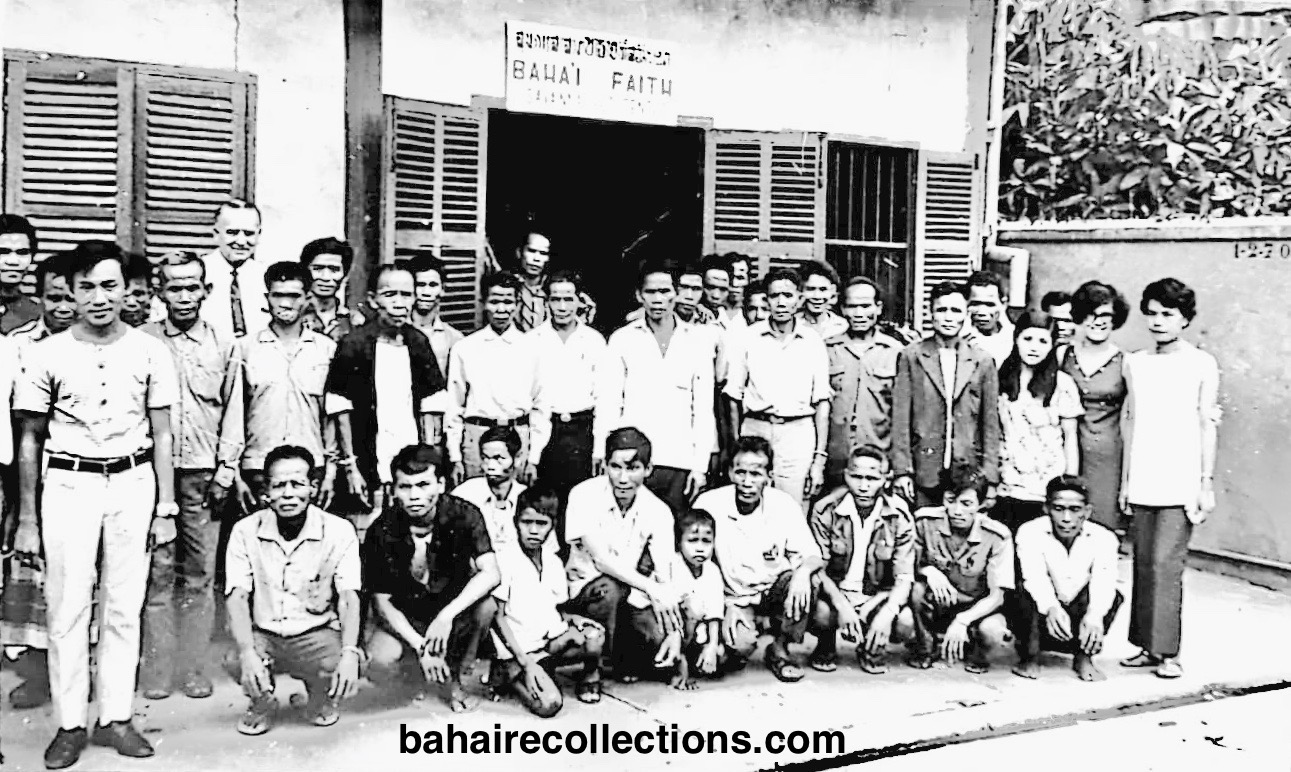
Mr. Featherstone meeting the Baha’is in Savannakhet in September 1974 at the Baha’i Center. Mr. Featherstone is standing on the left back row.
The second gathering was large and held in the open air. It was jointly organized by the efforts of the Local Spiritual Assembly of Viang Kham and the Viang Kham local government authorities. Because of the involvement of local government a few hundred people took part. Among the people that took part were a group of Buddhist monks with a High Maha that represented many Buddhist temples in Viang Kham area. The high Maha , other monks and the Hand of the Cause and his visiting companions were prominently seated. Some elders in the crowd were seated on straw mats on the floor while the rest of the audience either sat on the bare ground or stood in the back and around. The Taseng (chief in charge of many villages in Viang Kham area) introduced Mr. Featherstone as a high-level Bahá’í teacher, and invited him to speak.
Mr. Featherstone proceeded to the stage close to the High Maha monk to show his respect and greet him. Mr. Featherstone and the High Maha shook hands and hugged each other. Upon seeing this, the entire crowd cheered with joy and even some people said “Sah-Tu” meaning, “Praised be heaven”. This was a very unusual sight, since no layman could touch a monk physically – especially in public. Mr. Featherstone spoke about Progressive Revelation. After an hour of talk, a few questions were asked concerning the life of Baha’u’llah whereby satisfactory explanations was given. The gathering lasted over two hours, some refreshments and sweets were served and everyone left with the bright face and wide smile. It was a wonderful event whose effects and memory remained in the hearts of the believers for a long time and soon bore its results in furthering the Cause of God in Laos.
While he met with the National Spiritual Assembly of Laos, I saw how he helped the members to see the bigger picture in the face of difficulties the Faith had to experience in future. The difficulties could be caused mainly because of the lack of correct understanding of the Faith on the part of government officials, and partly because of not having enough deepened believers. True enough, the most unexpected thing began to happen in May 1975 and lasted three decades.
Mr. Featherstone visits South Korea
Mr. Featherstone visited Korea twice-1978 and in 1980. In his first visit, he met with the National Spiritual Assembly and the body of believers at the National Bahá’í Center in Seoul. It had been about a year since we had moved from Hong Kong to South Korea. In his meeting with Auxiliary Board Members he shared some writings about the works and the services of the Board Members. He asked them what was the most urgent need of the Faith in Korea? Everyone replied unanimously it was teaching and consolidation. Then he asked about the status of children classes and the youth activities in the Bahá’í communities. Everyone was quiet. There were no children classes anywhere except one in Seoul that was attended by the children of the pioneers. It was reported that there were several university students that occasionally went on teaching and consolidation to village communities close to the cities. Mr. Featherstone urged us to teach the youth as they are the future of any country.
On his second visit to Korea in 1980, he noticed the number of local spiritual assemblies and communities had drastically shrunk. He was unhappy and looked at me with a question in his face as to how that could have happened? I replied that perhaps it was the lack of clear vision and the result of materialism creeping into the country. Korea was shifting from the agrarian culture to industrial society, and that imposed pressure and tests on the existing Bahá’í communities. Mr. Featherstone tried all in his power to help us, the Bahá’í community, to understand the crucial period that their community was going through. He proposed every possibility that could help saving the local communities from disappearing. He gave us many tips and examples to guide our teaching and consolidation activities. We could not thank him enough the inspiration and guidance that he gave us.
One afternoon I was with him at his hotel room when a telephone call was received from a youth saying that a group of youths had gathered at the National Bahá’í Center without prior appointment, and wished to see him. When he informed his wife Madge and started getting ready to go to meet the youth, Madge advised him not to go as Mr. Featherstone had just caught a bad cold. But he still went. The youths were happy to see him and so was he. I thought to myself here is a Hand of the Cause of God totally detached from his own welfare when it came to the needs of the Faith.
The next day we set out on a trip to Pusan city by high speed train. Two local believers met us at train station and took us to our hotel. While staying for two nights in Pusan, two small gatherings were arranged. One was a dinner meeting with friends. Mr. Featherstone commented that he liked the small Bahá’í community of Pusan. But he said that since they were all seniors in age their community had not grown larger for some years. Therefore, he encouraged them to teach the university students. He said the youth are vigorous and energetic, once they experience the joy of teaching they bring in their fellow youths and friends. When he met with the youth he gave them maximum encouragement to serve the Faith tenaciously. On the way back to Seoul, he said he was worried about the growth of the Faith in Korea and was wondering how the Korean Bahá’í community would progress.
Mr. Featherstone visits Hong Kong
During the two years that we lived in Hong Kong from May 1975 to May 1977, Mr. Featherstone visited Hong Kong once during the Hong Kong International Conference that was held on 25-28 November 1976. He was commissioned by the House of Justice to consult with Counselors about a major disunity that had recently occurred in one particular country in our zone. Since we were all busy with the Conference, he consulted with all the five Counselors were present separately. Since I was the only residing Counselor in Hong Kong I was summoned to meet him several times. I had all along seen the much lighter side of Mr. Featherstone. This time I saw the very serious side of him, as the issue this time was defense and unity of the Cause. Mr. Featherstone was very straightforward about the nature of the problem and wanted to have more information to confirm his investigation. It was a very sensitive matter and he wanted to have my frank opinion. I explained clearly and exactly what I knew about the situation and contributed my humble opinion and suggestion. Following similar meetings, he had with the other Counselors he completed this mission. With the infallible wisdom and inspired guidance of the Universal House of Justice the problem was solved within less than a month, and everything assumed its normal process. Praised be the Lord.
Mr. Featherstone visits Australia
It was in 1985 while living in Carnarvon that I met Mr. Featherstone again. He had aged considerably, but was still active and dynamic. In his meetings with believers he shared the joyous news of new victories and development of the Faith in Asia, particularly in Iran despite the prevalent persecution. He encouraged the friends to seize the opportunities to redouble their effort with the ample of freedom while they still have.
One evening we were invited to dine with him at the home of one of the Persian believers. This was the last time that we met him. A year later in 1986 we moved back to South Korea. He passed away on 29 September 1990 in Kathmandu, Nepal.
These stories are not exhaustive. There are ten other Hands of the Cause whom I had met, of which I may write in the future. But these are some of the incidences I vividly remember. On the surface they may appear to be casual meetings and simple conversations with them. But my very association and conversation with them had tremendous and everlasting impact on me. They truly lived a very high standard of Bahá’í life and were the strongest defenders of the Covenant. While much of my learning in the Faith had come from the Writings, examples of living a pure Bahá’í life came from these Hands that I met, keeping in mind the Perfect Exemplar was the Master Himself. All the Hands of the Cause did not fail to instill in me further respect and highest love for the Guardian. They had so many praises on the majesty, magnanimity and greatness of the Guardian. They related many stories of their personal and intimate associations with the Guardian, of which I had not read elsewhere. I was astonished at the level of love they had for the Guardian. When asked to describe the Guardian they all mentioned that they simply did not have the capacity to describe him. After conversing with these Hands, a permanent void set into my soul – my not being privileged to meet in person the beloved Guardian, the Sign of God on Earth!
Dr. Firaydun Mithaq
Chieng Mai
Thailand
15 December, 2017
Copyright@bahairecollections.com